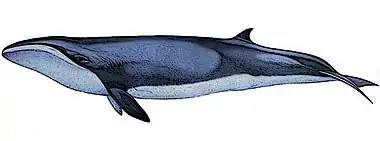Neobalaenidae
Neobalaenidae is a family of baleen whales (suborder Mysticeti) including the extant pygmy right whale. Although traditionally considered related to balaenids, a recent phylogenetic study by Fordyce and Marx (2013) recovered the living pygmy right whale as a member of Cetotheriidae, making it the only extant cetotheriid, but not all authors agree with this argument.
| Neobalaenidae | |
|---|---|
 | |
| Pygmy right whale Caperea marginata | |
| Scientific classification | |
| Kingdom: | Animalia |
| Phylum: | Chordata |
| Class: | Mammalia |
| Order: | Artiodactyla |
| Infraorder: | Cetacea |
| Parvorder: | Mysticeti |
| Family: | Neobalaenidae Miller, 1923 |
| Genera | |
| |
Taxonomy
The family Neobalaenidae was long restricted to the pygmy right whale from the Southern Hemisphere due to the unusual skeletal form of the species relative to other extant mysticetes.[1][2][3] Until the early 2010s Neobalaenidae was unknown from the fossil record despite a study by Sasaki et al. (2005) placing the divergence date of Neobalaenidae from other living baleen whales at 23 mya.[4]
Fordyce and Marx (2013) found that the pygmy right whale formed a well-supported clade with Eschrichtiidae and Balaenopteridae based on molecular data, and that, within 'cetotheres', it was most closely related to the herpetocetines (Herpetocetus and Nannocetus), rendering the pygmy right whale the only living species of Cetotheriidae.[5] For his part, Bisconti (2012) described the first pygmy right whale from the fossil record, Miocaperea, from the Pisco Formation of Peru.[6] Bisconti et al. (2013), however, found, based on morphological data, it to be more closely related to Balaenidae (the bowhead and right whales), but added that additional specimens are expected to resolve these conflicting results within a few years.[7] Cladistic analyses by Gol'din & Steeman (2015) and Gol'din (2018) partly agreed with Fordyce and Marx (2013) in recovering neobalaenids as closer to cetotheres than to Balaenidae, but disagreed with their recovery of the pygmy right whale as a herpetocetine, instead recovering Neobalaenidae outside Cetotheriidae.[8][9]
Fossil record
Examples of Neobalaenidae in the fossil record include Miocaperea, a couple of indeterminate earbones from Australia (one similar to Caperea),[10][11] and specimens from Pleistocene localities in the Northern Hemisphere.[12]
References
- Bouetel V, de Muizon C. 2006. The anatomy and relationships of Piscobalaena nana (Cetacea, Mysticeti), a Cetotheriidae s.s. from the early Pliocene of Peru. Geodiversitas 28, 319–395.
- Steeman ME. 2007. Cladistic analysis and a revised classification of fossil and recent mysticetes. Zool. J. Linn. Soc. 150, 875–89410.1111/j.1096-3642.2007.00313.x
- Churchill M, Berta A, Deméré TA. 2011. The systematics of right whales (Mysticeti: Balaenidae). Mar. Mamm. Sci. 28, 497–52110.1111/j.1748-7692.2011.00504.x
- Sasaki T, Nikaido M, Hamilton H et al. (2005) Mitochondrial phylogenetics and evolution of mysticete whales. Systematic Biology 54(1): 77–90.
- Fordyce, R. E.; Marx, F. G. (2013). "The pygmy right whale Caperea marginata: the last of the cetotheres". Proceedings of the Royal Society B: Biological Sciences. 280 (1753): 1–6. doi:10.1098/rspb.2012.2645. PMC 3574355. PMID 23256199.
- Bisconti, M. 2012. Comparative osteology and phylogenetic relationships of Miocaperea pulchra, the first fossil pygmy right whale genus and species (Cetacea, Mysticeti, Neobalaenidae). Zoological Journal of the Linnean Society 166: 876-911.
- Bisconti M, Lambert O, Bosselaers M. 2013. Taxonomic revision of Isocetus depauwi (Mammalia, Cetacea, Mysticeti) and the phylogenetic relationships of archaic “cetothere” mysticetes. Palaeontology 56(1):95-127.
- Gol’din P, Steeman ME. 2015. From problem taxa to problem solver: a new miocene family, tranatocetidae, brings perspective on baleen whale evolution. PLOS ONE 10(9):e0135500
- Gol'din P. (2018) New Paratethyan dwarf baleen whales mark the origin of cetotheres. PeerJ 6:e5800 https://doi.org/10.7717/peerj.5800
- Fitzgerald, E.M.G. 2012. Possible neobalaenid from the Miocene of Australia implies a long evolutionary history for the pygmy right whale Caperea marginata (Cetacea, Mysticeti). Journal of Vertebrate Paleontology 32:976-980.
- Felix G. Marx; Travis Park; Erich M.G. Fitzgerald; Alistair R. Evans, 2018. A Miocene pygmy right whale fossil from Australia". PeerJ. 6: e5025. doi:10.7717/peerj.5025.
- Tsai et. al., 2017. Northern pygmy right whales highlight Quaternary marine mammal exchange. Current Biology 27 (19):R1058-R1059. (link at http://www.cell.com/current-biology/fulltext/S0960-9822(17)31096-5)